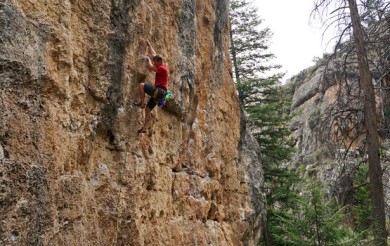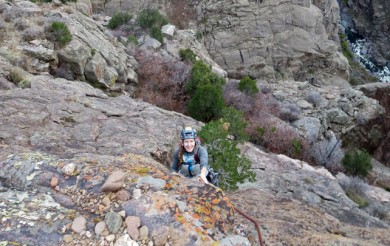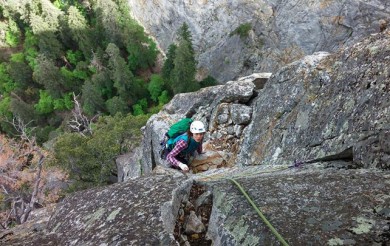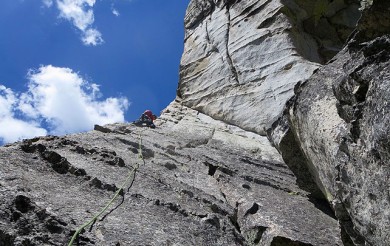The Lost Art of Nutcraft
 We were sitting around the living room, racking up for a weekend of climbing on the Front Range. My friend grabbed a set of nuts, and mentioned how he was excited to get to climb on some granite where he could actually use them. Around here, you see, we don’t get the opportunity often, as we’re either clipping bolts or sinking the occasional cam, so this was going to be a nice change. Come Saturday we climbed at different cliffs, and when we met up back at our friend’s house in the evening, I asked how it went. He said he got on a nice crack and was all fired up to place some good nuts, but each time he tried, the placements proved to be funky and he ended up just giving in and using a cam instead.
We were sitting around the living room, racking up for a weekend of climbing on the Front Range. My friend grabbed a set of nuts, and mentioned how he was excited to get to climb on some granite where he could actually use them. Around here, you see, we don’t get the opportunity often, as we’re either clipping bolts or sinking the occasional cam, so this was going to be a nice change. Come Saturday we climbed at different cliffs, and when we met up back at our friend’s house in the evening, I asked how it went. He said he got on a nice crack and was all fired up to place some good nuts, but each time he tried, the placements proved to be funky and he ended up just giving in and using a cam instead.
This got me thinking how I hardly ever place nuts, even when I travel to places where the rock is more conducive to it. Now, I’m not one to pass up a trucker stopper placement, and I think there are few finer things in the world of trad climbing then sinking that textbook nut that you know could hold your Subaru. But much of the time it simply seems faster for me to fire in a cam. I know there are ninjas out there who can fire in nuts with the speed of Bruce Lee’s fists into a variety of placements, but that is not me.
So the question is, has the widespread use of cams caused expert nutcraft to become a lost art? Or am I just a victim of my environment? Would love to hear what others think, and be honest. When you are at the next stance, ready to plug in some gear, what gets the first look on your harness?
5 Responses to The Lost Art of Nutcraft
Bulldog Creek Dog Walk (IV WI 4+)
Hayden Carpenter and Tom Bohanon recently repeated an obscure ice climb on the south side of Mt Sopris. Given a brief mention in Jack Robert’s ice guide, Bulldog Creek Walk is described as being 100 meters of WI 4. What they found was seven pitches of ice in a remote setting that makes for one […]
Connect with Us















Interesting question and one my group talks about quite a bit at our local crag. With the local rock being quartzite cams tend to walk a lot more than on rock with better friction hence passive pro tends to seem more bomber. That said, placing cams is much easier for both the leader and the follower. I personally tend to place more cams since they are quicker and allow me to keep moving.
My friends that have been climbing longer often joke about having a “passive pro challange” whereby we just leave the cams on the ground for a climb or two, but the convenience of putting in at least a couple of cams has left that as more of a utopian ideal and not something we’ve put into practice.
I always rack my stoppers when getting ready for a route and place at least one on each route I climb. I tend to place them in more comfortable stance as I’m not very good at sizing so they do at times take me a bit longer than a cam would. There is nothing like that bomber stopper and they work great for counter/directional pieces where you don’t want to sacrifice a cam.
I like Narc’s idea of a passive route. I might have to give that a try one of these days.
I also climb a lot on quartzite, and I’d say that I place nuts on just about 100% of those pitches. I’ve also led pitches and only placed nuts, even when I’ve had cams with me. Sometimes they just work a lot better. Having said that, overall I probably use cams more, but that’s not really a fair statement because I just climb routes that take bigger pieces of gear and I don’t have passive pro that big.
I think it depends how you phrase the question. Is nutcraft a lost art? Yeah, sure. I mean, when’s the last time any of us stacked nuts? But is it really lost? Everyone still knows how to place nuts even if they place cams a lot more, right? What knowledge is there that has actually been “lost”?
So let’s say it IS a lost art. Is it really lamentable? I mean, yeah, fashions from the 80s are gone too, but I for one am not too choked up about it…
I have climbed extensively all over the US for years, often with a rack lacking a single camming device, so this article startles me. Nuts are the core of my rack and always will be. Stoppers are the most bomber and affordable placement, so I am shocked at their decline in both proficiency and popularity. It may take a while to become a master at plugging them in, but even someone with average spatial cognition should be able to get good at placing them solid and without getting dangerously pumped after a few weeks.
I have never owned a full set of camming devices. My partners and I combine racks before leading pitches, and we always seem to have enough gear to get the job done without adding R ratings to our climbs. Hexes and Stoppers are still more than up to the task, and I will leave them behind on rappels without an ounce of remorse.
Cheapskate tip: when you do buy cams, stock up in small and XL sizes. Most partners have plenty for desperate hand and fist placements, and you’ll be set for finger cracks and to belay/protect large cracks.
I’m always amazed at all the comments I get when new partners of mine expound about how many stoppers I place and how well I place them- it never occured to me that this would be a unique talent- I consider it part of the trad leaders basic skill set. I would say that, on average, about a 1/3 to 1/2 my placements are stoppers, give or take.
I do agree with Narc, though- having passive only climbing days is a great idea, and its actually something I do fairly often- usually a couple of grades below my limit- its a great way to not only develop nut placing skills, but also creative protection skills- you’d be amazed at what you start to see after you run a few laps on routes with no cams on your harness.